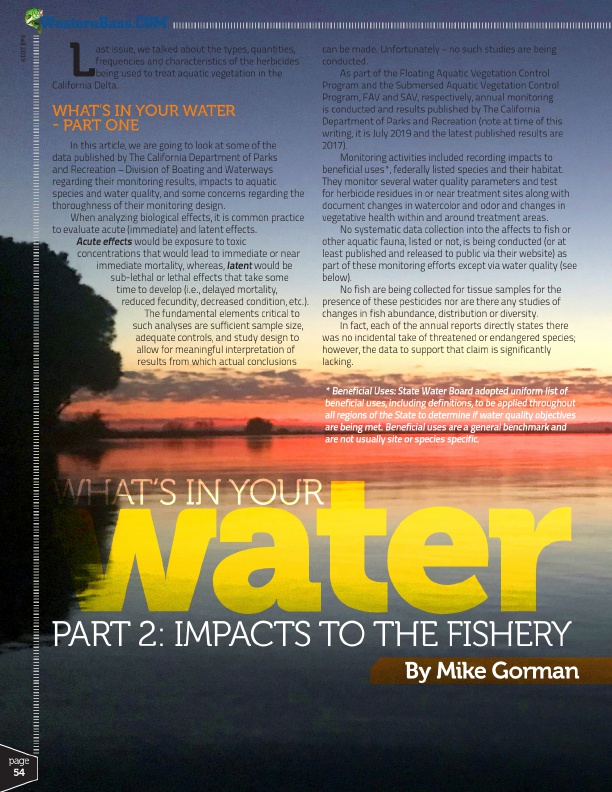
WHAT’S IN ® YOUR
w L ater
ast issue, we talked about the types, quantities,
frequencies and characteristics of the herbicides
being used to treat aquatic vegetation in the California Delta.
WHAT’S IN YOUR WATER - PART ONE
In this article, we are going to look at some of the data published by The California Department of Parks and Recreation – Division of Boating and Waterways regarding their monitoring results, impacts to aquatic species and water quality, and some concerns regarding the thoroughness of their monitoring design.
can be made. Unfortunately – no such studies are being conducted.
As part of the Floating Aquatic Vegetation Control Program and the Submersed Aquatic Vegetation Control Program, FAV and SAV, respectively, annual monitoring is conducted and results published by The California Department of Parks and Recreation (note at time of this writing, it is July 2019 and the latest published results are 2017).
Monitoring activities included recording impacts to beneficial uses*, federally listed species and their habitat. They monitor several water quality parameters and test for herbicide residues in or near treatment sites along with document changes in watercolor and odor and changes in
Fall 2019
When analyzing biological effects, it is common practice vegetative health within and around treatment areas.
to evaluate acute (immediate) and latent effects.
No systematic data collection into the affects to fish or
Acute effects would be exposure to toxic
other aquatic fauna, listed or not, is being conducted (or at
concentrations that would lead to immediate or near least published and released to public via their website) as
immediate mortality, whereas, latent would be
part of these monitoring efforts except via water quality (see
sub-lethal or lethal effects that take some
below).
time to develop (i.e., delayed mortality,
No fish are being collected for tissue samples for the
reduced fecundity, decreased condition, etc.). presence of these pesticides nor are there any studies of
The fundamental elements critical to changes in fish abundance, distribution or diversity.
such analyses are sufficient sample size,
In fact, each of the annual reports directly states there
adequate controls, and study design to was no incidental take of threatened or endangered species;
allow for meaningful interpretation of
however, the data to support that claim is significantly
results from which actual conclusions
lacking.
* Beneficial Uses: State Water Board adopted uniform list of beneficial uses, including definitions, to be applied throughout all regions of the State to determine if water quality objectives are being met. Beneficial uses are a general benchmark and are not usually site or species specific.
PART 2: IMPACTS TO THE FISHERY
By Mike Gorman
page 54
https://storage.westernbass.com/mag_wb/wb_mag_summer_2019/page30/index.html